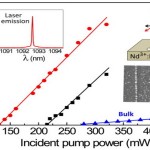Solid-state Lasers Go Nano
 Article: published in Nano Letters by Jorge Bravo-Abad, Department of Theoretical Condensed Matter Physics and IFIMAC researcher.
Article: published in Nano Letters by Jorge Bravo-Abad, Department of Theoretical Condensed Matter Physics and IFIMAC researcher.
Since the first experimental demonstration of the ruby laser in 1960, the development of solid-state lasers has led to an enormous variety of systems capable of generating laser action with characteristics relevant for applications in research, industry, medicine, or optical communications. Their versatile performance includes the possibility of operating in continuous-wave or ultrashort pulsed regimes, as well as single line or tunable sources, being accessible in very different configurations comprising from large devices delivering high power to fibers or compact microchip lasers for integrated optics. In the last years, laser action at the subwavelength regime has been observed by combining organic dye molecules or semiconductors with plasmonic nanostructures. However, nanoscale laser operation from solid-state lasers still remained a challenge.
A recent work published in Nano Letters by a collaboration between IFIMAC researcher Jorge Bravo-Abad and the research groups led by Luisa Bausá (UAM) and Javier Aizpurua (Center for Materials Physics, CSIC-UPV/EHU, and Donostia International Physics Center) has overcome this key challenge. In this work, the authors have demonstrated room temperature laser action with subwavelength confinement in a Nd3+-based solid-state laser by means of the localized surface plasmon resonances supported by chains of metallic nanoparticles. The researchers have shown a 50% reduction of the pump power at threshold and a remarkable 15-fold improvement of the slope efficiency with respect to the bulk laser operation. These results can be extended to a large diversity of solid-state lasers and open new prospects for the miniaturization of this class of light sources. [Full article]



















